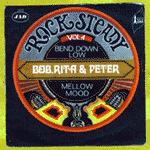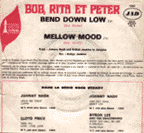|
On
January 7, 1967, Ethiopian New Year's Day, Bob
Marley attended a grounation, or Rastafarian religious
ceremony, at the home of Rasta elder Mortimo Planno
in the ghettos of western Kingston. Present that
night was American soul sensation Johnny
Nash, who was riding the top of the American
charts with great regularity, and often found
a welcome break from the rigors of the high-pressure
music scene in America by escaping to a house
overlooking the post of Kingston he owned on Russel
Heights. As Nash took his seat around the blazing
fire, and passed the chalice on the right hand
side, Planno came up to him with a scrawny young
man. "This is Bob Marley" he said, "He
is the best songwriter I know." His interest
piqued, Nash asked the shy youth if he could play
something. Twenty-odd songs later, Nash knew that
he was in the presence of genius. Returning to
his home in a flurry of excitement, Nash told
his business partner Danny Sims that he had just
met the most incredible writer he had ever encountered.
"He sang me a couple of dozen of his own
songs, and every one of them was a hit!"
 Within
a few days, formal business arrangements were
set up between Bob, his wife Rita, and their partner
Peter Tosh, and Johnny Nash, Arthur Jenkins their
producer, and Danny Sims. Nashs', Jenkins' and
Sims' combined first initials provided the name
for their label, JAD Records. The Wailers were
also signed on as performers, and Nash agreed
to release the groups material abroad on his own
label, while the Wailers maintained the rights
to their music in the Caribbean. It was Bob's
most fervent desire at this point to be, in the
words of his stateside producer of the time, Joe
Venneri, "a soul singer like Otis Redding."
To that end, Sims invited many of the most astute
studio heads in New York's booming scene to come
to Jamaica and discover the new rock steady music.
One engineer from Harry Belefonte's studio arrived,
curious musicians from the Atlantic label, even
the South African horn great Hugh Masekela - all
fascinated by the never-ending creations flowing
from the fecund pens of the Wailers in the rich,
supportive atmosphere of Beeston Street. Writers
came too. The Wailers were introduced to Jimmy
Norman, a high energy Tin Pan Alley composer and
collaborator of the Coasters who, with his partner
Norman Pyfrom,, crafted commercial cuts for the
important American R&B market, whose charts
the impatient Bob yearned to dominate. Within
a few days, formal business arrangements were
set up between Bob, his wife Rita, and their partner
Peter Tosh, and Johnny Nash, Arthur Jenkins their
producer, and Danny Sims. Nashs', Jenkins' and
Sims' combined first initials provided the name
for their label, JAD Records. The Wailers were
also signed on as performers, and Nash agreed
to release the groups material abroad on his own
label, while the Wailers maintained the rights
to their music in the Caribbean. It was Bob's
most fervent desire at this point to be, in the
words of his stateside producer of the time, Joe
Venneri, "a soul singer like Otis Redding."
To that end, Sims invited many of the most astute
studio heads in New York's booming scene to come
to Jamaica and discover the new rock steady music.
One engineer from Harry Belefonte's studio arrived,
curious musicians from the Atlantic label, even
the South African horn great Hugh Masekela - all
fascinated by the never-ending creations flowing
from the fecund pens of the Wailers in the rich,
supportive atmosphere of Beeston Street. Writers
came too. The Wailers were introduced to Jimmy
Norman, a high energy Tin Pan Alley composer and
collaborator of the Coasters who, with his partner
Norman Pyfrom,, crafted commercial cuts for the
important American R&B market, whose charts
the impatient Bob yearned to dominate.
 Their
aim was to create products that could garner international
air play, so after the initial recording of the
backing tracks and vocals, the tapes were taken
to New York City, to Harry Belefonte's studio,
where arranger-producers like Arthur Jenkins and
Joe Venneri often added soul style strings, horns,
and other instruments with some of the best studio
musicians of the time, many of them from Aretha
Franklin's band. The original recordings you hear
on this album are the original early mixes with
horns. "Don't forget, Bob's greatest desire
at this time was to be a soul singer, and he went
along with whatever we did on the top of his vocals".
"But," recalls Sims, "we still
couldn't get radio stations in America to play
our stuff. It just didn't sound like anything
else that was out there, and they didn't know
what to make of it." Many of the songs recorded
during that period never say the light of day
until many years later. That were popified readings
of some of the Wailers' rootsiest local hits like
"Mellow Mood" and "Put It On",
fancy dressed outings on "Touch Me"
and "Nice Time", all played by some
of the swingingest names of the day. Bernard Purdie,
Chuck Rainey, Richard Tee, and Eric Gale were
all heavy hitters bringing the island boys into
the big time. The training and support Bob got
from Jad coupled with his guaranteed $100 USD
a week in wages, encouraged and supported him
to become the professional he was when he signed
with Island Records in October of 1972 and the
final finest phase of his career commenced. Their
aim was to create products that could garner international
air play, so after the initial recording of the
backing tracks and vocals, the tapes were taken
to New York City, to Harry Belefonte's studio,
where arranger-producers like Arthur Jenkins and
Joe Venneri often added soul style strings, horns,
and other instruments with some of the best studio
musicians of the time, many of them from Aretha
Franklin's band. The original recordings you hear
on this album are the original early mixes with
horns. "Don't forget, Bob's greatest desire
at this time was to be a soul singer, and he went
along with whatever we did on the top of his vocals".
"But," recalls Sims, "we still
couldn't get radio stations in America to play
our stuff. It just didn't sound like anything
else that was out there, and they didn't know
what to make of it." Many of the songs recorded
during that period never say the light of day
until many years later. That were popified readings
of some of the Wailers' rootsiest local hits like
"Mellow Mood" and "Put It On",
fancy dressed outings on "Touch Me"
and "Nice Time", all played by some
of the swingingest names of the day. Bernard Purdie,
Chuck Rainey, Richard Tee, and Eric Gale were
all heavy hitters bringing the island boys into
the big time. The training and support Bob got
from Jad coupled with his guaranteed $100 USD
a week in wages, encouraged and supported him
to become the professional he was when he signed
with Island Records in October of 1972 and the
final finest phase of his career commenced.
By
Leroy Jodie Pierson & Roger
Steffens
Explore
Selassie is the Chapel
and the Best of the Wailers
portions of this boxset.
Learn
more about Bob, Bunny,
Peter, Rita
|

